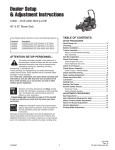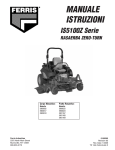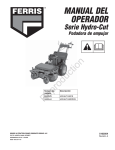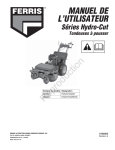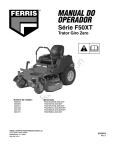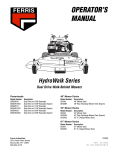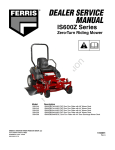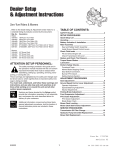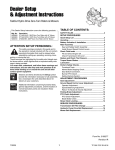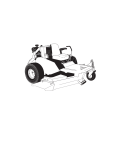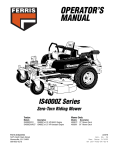Download Ferris Industries ISZKAV23/52 User's Manual
Transcript
FERRIS OPERATOR’S MANUAL ISZ Zero-Turn Riding Mower Models: ISZKAV23/52 ISZKAV23/61 Beginning Serial No: 2269 Ferris Industries 5375 North Main Street Munnsville, NY 13409 800-933-6175 22422 3/2000 F-ISZ-OWN-00 Table of Contents Identification Numbers .......................................2 Safety Rules & Information ................................3 Features & Controls ............................................6 Control Functions....................................................6 Safety Interlock System ..........................................7 Operating the Tractor..........................................8 General ...................................................................8 Checks Before Starting ...........................................8 Starting the Engine .................................................9 Stopping the Rider ..................................................9 Mowing....................................................................9 Pushing the Rider by Hand.....................................9 Zero Turn Driving Practice ....................................10 Storage .................................................................12 Starting After Long Term Storage .........................12 Regular Maintenance ........................................14 Maintenance Schedule .........................................14 Checking Tire Pressures.......................................14 Checking/Adding Fuel...........................................15 Fuel Filter ..............................................................15 Oil & Filter Change ...............................................15 Check / Change Air FIlter .....................................15 Check Hydraulic Oil Level.....................................15 Lubrication ............................................................16 Battery Maintenance .............................................17 Checking Battery Fluid..................................17 Cleaning the Battery and Cables..................17 Servicing the Mower Blades .................................18 Troubleshooting, Adjustments & Service .......19 Troubleshooting the Tractor ..................................19 Troubleshooting the Mower ..................................20 Seat Adjustment....................................................21 Ground Speed Control Lever Adjustment .............21 Speed Balancing Adjustment ................................21 Parking Brake Adjustment ....................................22 Suspension Height Adjustment .............................22 PTO Clutch Adjustment.........................................23 Blade Brake Check ...............................................23 Neutral Adjustment................................................24 Dampener and Return Spring Adjustment ............24 Cutting Height Adjustment ....................................25 Hydraulic Pump Drive Belt Replacement .............25 Mower Belt Replacement......................................26 Battery Service......................................................27 Checking the Battery Voltage ...........................27 Charging A Completely Discharged Battery .......................................27 Jump Starting with Auxiliary (Booster) Battery ............................27 Lawn Care & Mowing Information.............LC—1 International Symbols ................................LC—8 Technical Manuals ......................................LC—8 NOTE: In this manual, “left” and “right” are referred to as seen from the operating position. WARNING Engine exhaust from this product contains chemicals known, in certain quantities, to cause cancer, birth defects, or other reproductive harm. © Copyright 2000 Ferris Industries All Rights Reserved. Printed in USA. F-ISZ-OWN-00 Identification Numbers IDENTIFICATION TAG LOCATIONS When contacting your Authorized Dealer for replacement parts, service, or information YOU MUST HAVE THESE NUMBERS. FERRIS Tractor identification tag FERRIS INDUSTRIES, INC. MUNNSVILLE, NY 13409 MADE IN THE USA MODEL NO. SERIAL NO. XXXXXXX XXXXXXX IDENTIFICATION NUMBERS Record your model name/number, unit and mower deck manufacturer numbers and engine serial number in the space provided for easy reference. • • The Tractor I.D. tag is located on the inside of the main frame rail, behind the deck height plate. For location of Engine Serial Number, refer to the Engine Owner’s Manual. PRODUCT REFERENCE DATA Model Description Name/Number Unit MFG Number Unit SERIAL Number Mower Deck MFG Number Mower Deck SERIAL Number N/A Dealer Name Be sure to fill out and return the Warranty Registration Card supplied with your unit. N/A Date Purchased ENGINE REFERENCE DATA Engine Make/Model Engine ID/Serial Number Safety Rules & Information Read these safety rules and follow them closely. Failure to obey these rules could result in loss of control of unit, severe personal injury or death to you, or bystanders, or damage to property or equipment. This mowing deck is capable of amputating hands and feet and throwing objects. The triangle in text signifies important cautions or warnings which must be followed. GENERAL OPERATION • Read, understand, and follow all instructions in the manual and on the unit before starting. • Only allow responsible adults, who are familiar with the instructions, to operate the unit. • Clear the area of objects such as rocks, toys, wire, etc., which could be picked up and thrown by the blade(s). • Be sure the area is clear of other people before mowing. Stop unit if anyone enters the area. • Never carry passengers. • Do not mow in reverse unless absolutely necessary. Always look down and behind before and while travelling in reverse. • Be aware of the mower discharge direction and do not point it at anyone. Do not operate the mower without either the entire grass catcher or the deflector in place. • Slow down before turning. • Never leave a running unit unattended. Always disengage the PTO, set parking brake, stop engine, and remove keys before dismounting. • Turn off the PTO switch to disengage the blades when not mowing. • Stop engine before removing grass catcher or unclogging chute. • Mow only in daylight or good artificial light. • Do not operate the unit while under the influence of alcohol or drugs. • Watch for traffic when operating near or crossing roadways. • Use extra care when loading or unloading the unit into a trailer or truck. • Data indicates that operators, age 60 years and above, are involved in a large percentage of riding mower-related injuries. These operators should evaluate their ability to operate the riding mower safely enough to protect themselves and others from serious injury. SLOPE OPERATION Slopes are a major factor related to loss-of-control and tip-over accidents, which can result in severe injury or death. All slopes require extra caution. If you cannot back up the slope or if you feel uneasy on it, do not drive on it. WARNING Never operate on slopes greater than 30 percent (16.7°) which is a rise of three feet vertically in 10 feet horizontally. Select slow ground speed before driving onto slope. Use extra caution when operating on slopes with rear-mounted grass catcher. Mow UP and DOWN the slope, never across the face, use caution when changing directions and DO NOT START OR STOP ON SLOPE. Do • Mow up and down slopes, not across. • Remove obstacles such as rocks, tree limbs, etc. • Watch for holes, ruts, or bumps. Uneven terrain could overturn the unit. Tall grass can hide obstacles. • Use slow speed. Choose a slow speed so that you will not have to stop or change speed while on the slope. • Use extra care with grass catchers or other attachments. These can change the stability of the unit. • Keep all movement on the slopes slow and gradual. Do not make sudden changes in speed or direction. Do Not • Do not start or stop on a slope. If tires lose traction, disengage the blade(s) and proceed slowly straight down the slope. • Do not turn on slopes unless necessary, and then, turn slowly and gradually downhill, if possible. • Do not mow near drop-offs, ditches, or embankments. The mower could suddenly turn over if a wheel is over the edge of a cliff or ditch, or if an edge caves in. • Do not mow on wet grass. Reduced traction could cause sliding. • Do not try to stabilize the unit by putting your foot on the ground. • Do not use grass catcher on steep slopes. Safety Rules & Information CHILDREN • Never run a unit in an enclosed area. Tragic accidents can occur if the operator is not alert to the presence of children. Children are often attracted to the unit and the mowing activity. Never assume that children will remain where you last saw them. • Keep nuts and bolts, especially blade attachment bolts, tight and keep equipment in good condition. • Never tamper with safety devices. Check their proper operation regularly. • Keep children out of the mowing area and under the watchful care of another responsible adult. • Keep unit free of grass, leaves, or other debris buildup. Clean up oil or fuel spillage. • Be alert and turn unit off if children enter the area. • Stop and inspect the equipment if you strike an object. Repair, if necessary, before restarting. • Before and during reverse operation, look behind and down for small children. • Never carry children. They may fall off and be seriously injured or interfere with safe unit operation. • Never allow children to operate the unit. • Use extra care when approaching blind corners, shrubs, trees, or other objects that may obscure vision. TRANSPORTING AND STORAGE • Always observe safe refueling and fuel handling practices when refueling the unit after transportation or storage. • Always follow the engine manual instructions for storage preparations before storing the unit for both short and long term periods. • Always follow the engine manual instructions for proper start-up procedures when returning the unit to service. • Never store the unit or fuel container inside where there is an open flame or pilot light, such as in a water heater. Allow unit to cool before storing. SERVICE AND MAINTENANCE • Use extra care when handling gasoline and other fuels. They are flammable and vapors are explosive. a) Use only an approved container. b) Never remove fuel cap or add fuel with the engine running. Allow engine to cool before refueling. Do not smoke. c) Never refuel the unit indoors. • Never make adjustments or repairs with the engine running unless specified otherwise in the engine manufacturer’s manual. • Grass catcher components are subject to wear, damage, and deterioration, which could expose moving parts or allow objects to be thrown. Frequently check components and replace with manufacturer’s recommended parts, when necessary. • Mower blades are sharp and can cut. Wrap the blade(s) or wear gloves, and use extra caution when servicing them. • Check brake operation frequently. Adjust and service as required. • Use only factory authorized replacement parts when making repairs. • Always comply with factory specifications on all settings and adjustments. • Only authorized service locations should be utilized for major service and repair requirements. • Never attempt to make major repairs on this unit unless you have been properly trained. Improper service procedures can result in hazardous operation, equipment damage and voiding of manufacturer’s warranty. Safety Rules & Information SAFETY DECALS This unit has been designed and manufactured to provide you with the safety and reliability you would expect from an industry leader in outdoor power equipment manufacturing. Although reading this manual and the safety instructions it contains will provide you with the necessary basic knowledge to operate this equipment safely and effectively, we have placed several safety labels on the unit to remind you of this important information while you are operating your unit. All DANGER, WARNING, CAUTION and instructional messages on your rider and mower should be carefully read and obeyed. Personal bodily injury can result when these instructions are not followed. The information is for your safety and it is important! The safety decals below are on your rider and mower. If any of these decals are lost or damaged, replace them at once. See your local dealer for replacements. These labels are easily applied and will act as a constant visual reminder to you, and others who may use the equipment, to follow the safety instructions necessary for safe, effective operation. OPERATION To Start Engine: To Operate PTO Clutch: Seat must be occupied, PTO Switch OFF, Parking Brake ON and both control handles are locked in Neutral. Operator must be in seat. Pull up to Engage. Push down to Disengage. When Operator Leaves Seat: To Stop Engine: Engage Parking Brake, Throttle at half to full, turn Ignition Switch Off. Before Leaving Machine: Turn PTO switch off, shut off engine, remove key, and set Parking Brake Engine will shut off if PTO is on. Engine will shut off of Parking Brake is off. Engine will shut off if both control levers are not locked in neutral. GROUND SPEED AND STEERING LEVERS Right lever controls speed and direction of right drive wheel. Notch is neutral lock. Left lever controls speed and direction of left drive wheel. Notch is neutral lock. Steer by slowing the lever in the direction of the turn. PARKING BRAKE LEVER Pull to set Parking Brake. Push to release Parking Brake. DECK LIFT PEDAL Push to raise deck. CUTTING HEIGHT ADJUSTMENT PIN DO NOT TOW! Damage may result to Hydrostatic Transmission. Decal - Warning/Danger Part No. 45567 Decal - Operation & Controls Part No. 45559 DANGER DANGER ROTATING CUTTING BLADE Do not put hands or feet under mower deck while blade is rotating. ROTATING CUTTING BLADE Do not operate mower without deflector or entire grass catcher in place. 1704277 1704276 Decal - Danger Part No. 1704276 WARNING BEWARE OF POWER DRIVEN PARTS Decal - Warning Part No. 20337 Decal - Danger Part No. 1704277 DANGER ROTATING PARTS UNDER ENGINE. KEEP HANDS AND FEET CLEAR. STOP ENGINE BEFORE SERVICING. Decal - Danger Part No. 22143 Features & Controls of the Zero Turn Rider A. Ground Speed Control Levers B. Seat Adjustment Lever These levers control the ground speed of the rider. The left lever controls the left rear drive wheel and the right controls the right rear drive wheel. The seat can be adjusted forward and back. Move the lever forward, position the seat as desired, and release the lever to lock the seat in position. Moving a lever forward increases the FORWARD speed of the associated wheel, and pulling back on a lever increases the REVERSE speed. C. Ignition Switch The ignition switch starts and stops the engine, it has three positions: Note: The further a lever is moved away from the neutral position the faster the drive wheel will turn. See the Operating the Zero Turn Rider section for steering instructions. OFF Stops the engine and shuts off the electrical system. RUN Allows the engine to run and powers the electrical system. START Cranks the engine for starting. NOTE: Never leave the ignition switch in the RUN position with the engine stopped–this drains the battery. 6 Features & Controls SAFETY INTERLOCK SYSTEM D. Parking Brake Handle The parking brake is applied by pulling UP on the parking brake handle until it locks over-center. To release the parking brake, push the handle DOWN. This unit is equipped with safety interlock switches and other safety devices. These safety systems are present for your safety, do not attempt to bypass safety switches, and never tamper with safety devices. Check their operation regularly. E. PTO (Power Take Off) Switch The PTO switch engages and disengages the mower. Pull UP on the switch to engage, and push DOWN to disengage. Operational SAFETY Checks F & G. Deck Lift Pedal & Cutting Height Adjustment Pin Your unit is equipped with a seat switch safety system. Check the seat switch operation every fall and spring with the following tests. These control the cutting height of the mower deck. Test 1 — Engine should NOT crank if: • PTO switch is engaged, OR Depress the pedal until it locks into the TRANSPORT position. Place the adjustment pin in the desired cutting height and release the lift pedal. • Parking brake is not engaged, OR H & I. Throttle / Choke Control • Motion control handles are not in the NEUTRAL position, OR Pulling the round choke control knob (I) out fully chokes the engine for cold starts. (A warm engine may not require choking.) Moving the throttle control (H) fully forward is FULL throttle position. Always operate the unit at FULL throttle when mowing. • Operator is not on the seat. Test 2 — Engine SHOULD crank if: • PTO switch is NOT engaged, AND • Parking brake is engaged, AND • Motion control handles are locked in the NEUTRAL position, AND J. Hour Meter Measures the time of the PTO being engaged. • Operator is on the seat. K. Fuel Shut Off Valve Test 3 — Engine should SHUT OFF if: • Operator rises off seat with PTO engaged, OR Turning the handle to the desired position determines which tank will be supplying fuel. With the handle pointing forward, it will draw fuel from the left-hand tank. With the handle pointed towards the rear, it will draw fuel from the right-hand fuel tank. With the handle pointing towards the right, it will shut off fuel flow to the engine. • Operator rises off seat with parking brake disengaged. Test 4 — Blade Brake Check Mower blades and mower drive belt should come to a complete stop within five seconds after electric PTO switch is turned off (or operator rises off seat). If mower drive belt does not stop within five seconds, see your dealer. NOTE: Once the engine has stopped, PTO switch must be turned off, parking brake must be engaged, and the motion control handles must be locked in the NEUTRAL position after the operator returns to the seat in order to start the engine. WARNING If the unit does not pass a safety test, do not operate it. See your authorized dealer. Under no circumstance should you attempt to defeat the purpose of the safety interlock system. 7 Operating the Zero Turn Rider GENERAL OPERATING SAFETY WARNING Before first time operation: • Be sure to read all information in the Safety and Operation sections before attempting to operate this tractor and mower. Never allow passengers to ride on the unit. Before leaving the operators position for any reason, engage the parking brake, disengage the PTO, stop the engine and remove the key. • Become familiar with all of the controls and how to stop the unit. To reduce fire hazard, keep the engine, tractor and mower free of grass, leaves and excess grease. Do not stop or park tractor over dry leaves, grass or combustible materials. • Drive in an open area without mowing to become accustomed to the unit. Gasoline is highly flammable and must be handled with care. Never fill the tank when the engine is still hot from recent operation. Do not allow open flame, smoking or matches in the area. Avoid over-filling and wipe up any spills. CHECKS BEFORE STARTING • Check that crankcase is filled to full mark on dipstick. See the engine Operators Manual for instructions and oil recommendations. • Make sure all nuts, bolts, screws and pins are in place and tight. • Adjust the seat position, and make certain you can reach all controls from operators position. • Fill the fuel tanks with fresh fuel. Refer to engine manual for fuel recommendations. DANGER A OPERATING ON SLOPES CAN BE DANGEROUS A Never operate on slopes greater than 30 percent (16.7°) which is a rise of three feet vertically in 10 feet horizontally. Operate the unit at a slow ground speed when driving onto slope. B Use extra caution when operating on slopes with rear-mounted grass catcher. Mow UP and DOWN the slope, never across the face, use caution when changing directions and DO NOT START OR STOP ON SLOPE. Figure 2. Pre-start Checks A. Fuel Tank Filler Neck B. Crankcase Oil Fill 8 Operating the Zero Turn Rider WARNING MOWING 1. Engage the parking brake. Make sure the PTO switch is disengaged, the motion control handles are locked in the NEUTRAL position and the operator is on the seat. 2. Start the engine (see STARTING THE ENGINE). 3. Set the mower cutting height. 4. Set the throttle to FULL. 5. Engage the PTO by pulling up on the PTO switch (E, Figure 1). 6. Begin mowing. See the LC Section for tips on mowing patterns, lawn care, and trouble shooting information. 7. When finished, shut off the PTO. 8. Stop the engine (see STOPPING THE TRACTOR AND ENGINE). If you do not understand how a specific control functions, or have not yet thoroughly read the FEATURES & CONTROLS section, do so now. Do NOT attempt to operate the tractor without first becoming familiar with the location and function of ALL controls. STARTING THE ENGINE 1. While sitting in the operators seat, engage the parking brake and make sure the PTO switch is disengaged and the motion control handles are locked in the NEUTRAL position. 2. NOTE: A warm engine may not require choking. Set the engine throttle control (H, Figure 1) to FAST throttle position. Then fully close the choke (I, Figure 1) by pulling the knob OUT fully. 3. Insert the key into the ignition switch (C, Figure 1) and turn it to START. 4. After the engine starts, gradually open the choke (push knob down fully). Warm up the engine by running it for at least a minute before engaging the PTO switch or driving the rider. PUSHING THE RIDER BY HAND DO NOT TOW RIDER Towing the unit will cause hydraulic pump and wheel motor damage. Do not use another vehicle to push or pull this unit. 5. After warming the engine, ALWAYS operate the unit at FULL THROTTLE when mowing. In the event of an emergency the engine can be stopped by simply turning the ignition switch to STOP. Use this method only in emergency situations. For normal engine shut down follow the procedure given in STOPPING THE RIDER. 1. Disengage the PTO, engage the parking brake, turn the ignition OFF, and remove the key. 2. Locate the hydraulic by-pass handles under the machine, behind the fuel tank belly pan. The handles are equipped with a yellow cap on the end for easy identification. 3. To disengage the pumps (free-wheel position), move the hydraulic by-pass handles towards the left-hand side of the machine, approximately 90 degrees from its original position. STOPPING THE RIDER 1. Returning the ground speed control levers (A, Figure 1) to the middle position will stop tractor movement. Pivot the levers outward and lock them in NEUTRAL. 2. Disengage the PTO by pushing down on the PTO switch (E, Figure 1). 3. Engage the parking brake by pulling the handle (D, Figure 1) up until it locks into position. 4. Move the throttle control (H, Figure 1) to mid-throttle position and turn the ignition key to OFF. Remove the key. 4. Disengage the parking brake. The tractor can now be pushed by hand. 5. After moving the tractor, re-engage the pumps (drive position) by moving the hydraulic by-pass handles towards the right-hand side of the machine until they stop. 9 Operating the Zero Turn Rider ZERO TURN DRIVING PRACTICE Smooth Travel The lever controls of the Zero Turn rider are RESPONSIVE . The lever controls of the Zero Turn rider are responsive, and learning to gain a smooth and efficient control of the rider’s forward, reverse, and turning movements will take some practice. The BEST method of handling the ground speed control levers is in three steps — as shown in Figure 3. Spending some time going through the maneuvers shown and becoming familiar with how the unit accelerates, travels, and steers — before you begin mowing — is absolutely essential to getting the most out of the Zero Turn rider. FIRST place your hands onto the levers as shown. Locate a smooth, flat area of your lawn — one with plenty of room to maneuver. (Clear the area of objects, people and animals before you begin.) Operate the unit at mid-throttle during this practice session (ALWAYS operate at full throttle when mowing), and turn slowly to prevent tire slippage and damage to your lawn. SECOND, to go forward gradually push the levers forward with your palms. We suggest you begin with the Smooth Travel procedure to the right, and then advance through the forward, reverse, and turning maneuvers. THIRD, to speed up move the levers farther forward. To slow down smoothly, slowly move the levers toward neutral. You must release the parking brake prior to moving the control levers inward. Figure 3. Move Control Levers Gradually BASIC DRIVING Forward Travel Practice Reverse Travel Practice Gradually move both ground speed control levers — evenly FORWARD from neutral. Slow down and repeat. LOOK DOWN & BEHIND, then gradually move both ground speed control levers evenly BACK from neutral. Slow down and repeat. NOTE: Straight forward travel takes practice. If necessary, top speed can be balance-adjusted — see the Speed Balancing Adjustment in the Adjustments section near the back of this manual. NOTE: Practice backing up for several minutes before attempting to do so near objects. The rider turns sharply in reverse as well as forward, and backing up straight takes practice. Reverse Travel Forward Travel Figure 4. Forward Travel Figure 5. Forward Travel 10 Operating the Zero Turn Rider Practice Turning Around a Corner Practice Turning In Place While traveling forward allow one handle to gradually return back toward neutral. Repeat several times. To turn in place, “Zero Turn,” gradually move one ground speed control lever forward from neutral and one lever back from neutral simultaneously. Repeat several times. NOTE: To prevent pivoting directly on the tire tread, it is best to keep both wheels going at least slightly forward. NOTE: Changing the amount each lever is pulled—forward or back, changes the “pivot point” you turn on. Turning In-Place Executing Turns Figure 6. Turning Around a Corner Figure 7. Turning in Place ADVANCED DRIVING Executing an End-Of-Row Zero Turn Your Zero Turn Rider’s unique ability to turn in place allows you to turn around at the end of a cutting row rather than having to stop and Y-turn before starting a new row. For example, to execute a right end-of row Zero Turn: 1. Slow down at the end of the row. 2. Move the LEFT ground speed control lever forward slightly while moving the RIGHT ground speed control lever back to center and then slightly back from center. 3. Begin mowing forward again. This technique turns the rider RIGHT and slightly overlaps the row just cut —eliminating the need to back up and re-cut missed grass. As you become more familiar and experienced with operating the Zero Turn rider, you will learn more maneuvers that will make your mowing time easier and more enjoyable. Remember, the more you practice, the better your control of the Zero Turn will be! 11 Operating the Zero Turn Rider STORAGE WARNING Temporary Storage (30 Days Or Less) Never store the unit, with gasoline in engine or fuel tank, in a heated shelter or in enclosed, poorly ventilated enclosures. Gasoline fumes may reach an open flame, spark or pilot light (such as a furnace, water heater, clothes dryer, etc.) and cause an explosion. Remember, the fuel tank will still contain some gasoline, so never store the unit indoors or in any other area where fuel vapor could travel to any ignition source. Fuel vapor is also toxic if inhaled, so never store the unit in any structure used for human or animal habitation. Here is a checklist of things to do when storing your unit temporarily or in between uses: Handle gasoline carefully. It is highly flammable and careless use could result in serious fire damage to your person or property. • Keep the unit in an area away from where children may come into contact with it. If there’s any chance of unauthorized use, remove the spark plug (s) and put in a safe place. Be sure the spark plug opening is protected from foreign objects with a suitable cover. Drain fuel into an approved container outdoors away from open flame or sparks. • If the unit can’t be stored on a reasonable level surface, chock the wheels. 10. Drain fuel system completely or add a gasoline stabilizer to the fuel system. If you have chosen to use a fuel stabilizer and have not drained the fuel system, follow all safety instructions and storage precautions in this manual to prevent the possibility of fire from the ignition of gasoline fumes. Remember, gasoline fumes can travel to distant sources of ignition and ignite, causing risk of explosion and fire. • Clean all grass and dirt from the mower. Long Term Storage (Longer Than 30 Days) Before you store your unit for the off-season, read the Maintenance and Storage instructions in the Safety Rules section, then perform the following steps: 1. Drain crankcase oil while engine is hot and refill with a grade of oil that will be required when unit is used again. NOTE: Gasoline, if permitted to stand unused for extended periods (30 days or more), may develop gummy deposits which can adversely affect the engine carburetor and cause engine malfunction. To avoid this condition, add a gasoline stabilizer to the fuel tank and run the engine a few minutes, or drain all fuel from the unit before placing it in storage. 2. Prepare the mower deck for storage as follows: a. Remove mower deck from the unit. b. Clean underside of mower deck. c. Coat all bare metal surfaces with paint or light coat of oil to prevent rusting. 3. Clean external surfaces and engine. STARTING AFTER LONG TERM STORAGE 4. Prepare engine for storage. See engine owner’s manual. Before starting the unit after it has been stored for a long period of time, perform the following steps. 5. Clean any dirt or grass from cylinder head cooling fins, engine housing and air cleaner element. 1. Remove any blocks from under the unit. 6. Cover air cleaner and exhaust outlet tightly with plastic or other waterproof material to keep out moisture, dirt and insects. 3. Unplug the exhaust outlet and air cleaner. 2. Install the battery if it was removed. 4. Fill the fuel tank with fresh gasoline. See engine manual for recommendations. 7. Completely grease and oil unit as outlined in the Normal Care section. 5. See engine owner’s manual and follow all instructions for preparing engine after storage. 8. Clean up unit and apply paint or rust preventative to any areas where paint is chipped or damaged. 6. Check crankcase oil level and add proper oil if necessary. If any condensation has developed during storage, drain crankcase oil and refill. 9. Be sure the battery is filled to the proper level with water and is fully charged. Battery life will be increased if it is removed, put in a cool, dry place and fully charged about once a month. If battery is left in unit, disconnect the negative cable. 7. Inflate tires to proper pressure. Check fluid levels. 8. Start the engine and let it run slowly. DO NOT run at high speed immediately after starting. Be sure to run engine only outdoors or in well ventilated area. 12 Notes 13 Regular Maintenance MAINTENANCE SCHEDULE & PROCEDURES The following schedule should be followed for normal care of your rider and mower. You will need to keep a record of your operating time. Determining operating time is easily accomplished by observing the hour meter. See Page Before First Use Check Safety Interlock System 7 X X Check Rider Brakes 22 X X 23 See Page X Before First Use SAFETY ITEMS Check Mower Blade Stopping Time NORMAL CARE ITEMS Before Each Use Every 5 Hours Before Each Use Every 5 Hours X X X X Every 25 Hours Every 25 Hours Every 100 Hours X Every 100 Hours Check Rider/Mower for loose hardware — Check Engine Oil Level 15* Check Engine Air Filter 15* Change Engine Oil & Filter ** 15* Lubricate Rider & Mower 16 Check Tire Pressure 14 X ***X Check Hydraulic Fluid 15 X ***X Check Fuel Filter 15 X Clean Battery & Cables 17 X Clean & Sharpen Mower Blades 18 X Inspect Spark Plug 15* X X X ***X ***X Every 50 Hours ***X CHECK TIRE PRESSURES Tire Pressure should be checked periodically, and maintained at the levels shown in the chart. Note that these pressures may differ slightly from the “Max Inflation” stamped on the side-wall of the tires. The pressures shown provide proper traction, improve cut quality, and extend tire life. Pressure Front 20 psi (138 kPa) Rear 15 psi (103 kPa) Figure 9. Checking Tire Pressure 14 Spring & Fall X * See the engine manufacturer's owner's manual. ** Change original engine oil after first 5 hours of operation. *** More often in hot (over 85° F: 30° C) weather or dusty operating conditions. Tire Spring & Fall ***X Regular Maintenance CHECKING / ADDING FUEL WARNING To add fuel: 1. Remove the fuel cap (see A, Figure 2). 2. Fill the tank. Do not overfill. Leave approximately 1” of room in the tank for fuel expansion. Refer to your engine manual for specific fuel recommendations. 3. Install and hand tighten the fuel cap. Gasoline is highly flammable and must be handled with care. Never fill the tank when the engine is still hot from recent operation. Do not allow open flame, smoking or matches in the area. Avoid over-filling and wipe up any spills. Do not remove fuel filter when engine is hot, as spilled gasoline may ignite. DO NOT spread hose clamps further than necessary. Ensure clamps grip hoses firmly over filter after installation. 4. Repeat same process for opposite tank. FUEL FILTER The fuel filter is located in the fuel line between fuel shut off valve and carburetor, near the fuel pump. If filter is dirty or clogged, replace as follows: 1. Shut off the fuel valve. 2. Disconnect the negative battery cable. 3. Place a container below the filter to catch spilled fuel. 4. Using a pliers, open and slide hose clamps from fuel filter. 5. Remove hoses from filter. 6. Install new filter in proper flow direction in fuel line. Do not use gasoline containing METHANOL, gasohol containing more than 10% ethanol, gasoline additives, premium gasoline, or white gas because engine/fuel system damage could result. 7. Secure with hose clamps. 8. Reconnect the negative battery cable when finished. OIL & FILTER CHANGE Refer to engine owners manual. B CHECK / CHANGE AIR FILTER A Refer to engine owners manual. REPLACE SPARK PLUG Figure 10. Checking Hydraulic Oil Level A. Hydraulic Oil Reservoir (Right-side shown) B. Breather Refer to engine owners manual. CHECK HYDRAULIC OIL LEVEL NOTE: Do not open the hydraulic oil reservoir unless oil is being added. 1. Remove the breather (B, Figure 10) from the filler neck of the hydraulic oil reservoir (A, Figure 10). 2. With a small diameter steel dowel, use it as a dipstick to check the oil level. When cold, there should be 3” of oil on the dowel. 3. If necessary, add either Mobil 1, 15W-50 synthetic oil or Castrol Syntec 5W-50 oil. DO NOT use conventional oils. Make sure area around the filler neck is free of dust, dirt, or other debris. 15 Regular Maintenance LUBRICATION Lubricate the unit at the locations shown in Figures 11 through 13 as well as the following lubrication points. Grease: • • • • • • • • front caster wheel axles motion control pivots suspension a-arms rear deck mounts deck lift pivots deck lift foot pedal front pivot frame blade spindles Figure 11. Suspension Lubrication Top & Bottom, Left & Right Use grease fittings when present. Disassemble parts to apply grease to moving parts when grease fittings are not installed. Not all greases are compatible. Ferris Red Grease is recommended, automotive-type high-temperature, lithium grease may be used when this is not available. Oil: • control handle pivots • floor plate hinge • discharge chute hinge Generally, all moving metal parts should be oiled where contact is made with other parts. Keep oil and grease off belts and pulleys. Remember to wipe fittings and surfaces clean both before and after lubrication. Figure 12. Rear Control Pivot Lubrication Figure 13. Lift Pivot Lubrication 16 Regular Maintenance BATTERY MAINTENANCE WARNING Checking the Battery Fluid Be careful when handling the battery. Avoid spilling electrolyte. Keep flames and sparks away from the battery. 1. Raise the seat plate to access battery. 2. Remove the rubber strap and battery box cover. 3. Remove the battery filler cap (A, Figure 14). Fluid must be even with the split ring full mark. If not, add distilled water. When removing or installing battery cables, disconnect the negative cable FIRST and reconnect it LAST. If not done in this order, the positive terminal can be shorted to the frame by a tool. 4. Reinstall the filler cap. 5. Reinstall the the battery box cover and rubber strap. Cleaning the Battery and Cables B 1. Disconnect the cables from the battery, negative cable first (C, Figure 14). 2. Remove the battery and clean the compartment with a solution of baking soda and water. 3. Clean the battery terminals and cable ends with a wire brush until shiny. A 4. Reinstall the battery and reattach the battery cables, positive cable first (see B, Figure 14) C 5. Coat the cable ends and battery terminals with petroleum jelly or non-conducting grease. Figure 14. Battery Compartment A. Vent Cap(s) B. Positive (+) Cable & Terminal C. Negative (-) Cable & Terminal 17 Regular Maintenance SERVICING THE MOWER BLADES 1. Blades should be sharp and free of nicks and dents. If not, sharpen blades as described in following steps. 2. To remove blade for sharpening, use a wood block to hold blade while removing the blade mounting bolt (Figure 15). 3. Use a file to sharpen blade to fine edge. Remove all nicks and dents in blade edge. If blade is severely damaged, it should be replaced. 4. Balance the blade as shown in Figure 16. Center the blade’s hole on a nail lubricated with a drop of oil. A balanced blade will remain level. LOOSEN 5. Reinstall each blade with the tabs pointing up toward deck as shown in Figure 17. The five (5) blade spacers, blade, washer and bolt must be reinstalled in the exact same order in which they were removed. Secure with a bolt and hex nut. Use a wooden block to prevent blade rotation and torque bolts to 70 ft.lbs. (94 N.m.). Figure 15. Removing the Blade Nail WARNING For your personal safety, blade mounting bolts must each be installed with a flat washer then securely tightened. Torque blade mounting bolts to 70 ft.lbs. (94 N.m.) Figure 16. Balancing The Blade B A TIGHTEN Figure 17. Installing The Blade A. 4x4 Wood Block B. Flat Washer 18 C. Blade Bolt Troubleshooting, Adjustment & Service Rider Troubleshooting Continued. PROBLEM CAUSE REMEDY Engine runs, but rider will not drive. 1. Hydraulic release valve(s) in “open” position. 2. Belt is broken. 3. Drive belt slips. 4. Brake is not fully released. 1. Clutch is out of adjustment. 2. Pulleys or belt greasy or oily. 3. Belt stretched or worn. 1. Brake is incorrectly adjusted. 2. Brake caliper pads worn. 1. Steering linkage is loose. 2. Improper tire inflation. 1. Turn valve(s) clockwise to close. Rider drive belt slips. Brake will not hold. Rider steers or handles poorly. 2. 3. 4. 1. 2. 3. 1. 2. 1. 2. See Drive Belt Replacement. See problem and cause below. See authorized service dealer See authorized service dealer. Clean as required. Replace belt. See Brake Adjustment. Replace with new brake pads. Check and tighten any loose connections. See Regular Maintenance Section. TROUBLESHOOTING THE MOWER PROBLEM CAUSE REMEDY Mower will not raise. 1. Lift linkage not properly attached or damaged. 1. Mower not leveled properly. 2. Rider tires not inflated equally or properly. 1. Engine speed too slow. 2. Ground speed too fast. 3. Blades are dull. 1. See authorized service dealer for repair. Mower cut is uneven. Mower cut is rough looking. Engine stalls easily with mower engaged. Excessive mower vibration. Excessive belt wear or breakage. Mower drive belt slips or fails to drive. 4. Mower drive belt slipping because it is oily or worn. 5. Blades not properly fastened to arbors. 1. Engine speed too slow. 2. Ground speed too fast. 3. Cutting height set too low. 4. Discharge chute jamming with cut grass. 1. Blade mounting screws are loose. 2. Mower blades, arbors, or pulleys are bent. 3. Mower blades are out of balance. 4. Belt installed incorrectly. 1. Bent or rough pulleys. 2. Using incorrect belt. 1. Idler pulley spring broken or not properly attached. 2. Mower drive belt broken. 20 1. See Mower Adjustment. 2. See Regular Maintenance Section. 1. Set throttle to full. 2. Decrease Ground Speed. 3. Sharpen or replace blades. See Mower Blade Service. 4. Clean or replace belt as necessary. 5. See Servicing the Mower Blades. 1. Set to full throttle. 2. Decrease Ground Speed. 3. Cut tall grass at maximum cutting height during first pass. 4. Cut grass with discharge pointing toward previously cut area. 1. Tighten to 45-55 ft.lbs. (61-75 N.m.). 2. Check and replace as necessary. 3. Remove, sharpen, and balance blades. See Maintenance Section. 4. Reinstall Correctly. 1. Repair or replace. 2. Replace with correct belt. 1. Repair or replace as needed. 2. Replace drive belt. Troubleshooting, Adjustment & Service SEAT ADJUSTMENT Seat Adjustment Lever See Figure 18. The seat can be adjusted forward and back. Move the lever forward, position the seat as desired, and release the lever to lock the seat into position. GROUND SPEED CONTROL LEVER ADJUSTMENT Figure 18. Seat Adjustment The control levers can be adjusted in two ways. The alignment of the control levers can be adjusted along with the placement of the levers (how close the ends are to one another) can be adjusted. A To Adjust the Handle Alignment Loosen the mount bolts (A, Figure 19) and pivot the lever(s) (C, Figure 19) to align with each other. C B To Adjust the Handle Placement Loosen the jam nuts and adjust the placement bolt (B, Figure 19) in or out to properly adjust the lever end spacing. SPEED BALANCING ADJUSTMENT Figure 19. Control Lever Adjustment A. Alignment Hardware B. Placement Hardware C. Ground Speed Control Lever If the rider veers to the right or left when the ground speed control levers are in the maximum forward position, the top speed of each of these levers can be balanced by turning the adjustment bolt(s) (A, Figure 20). Only adjust the speed of the wheel that is traveling faster. FRONT To Reduce the Speed of the Faster Wheel 1. Loosen the lock nut. 2. turn the top speed adjustment bolt COUNTERCLOCKWISE to reduce the speed. 3. Retighten the lock nut when adjustment is complete. WARNING C DO NOT adjust the tractor for a faster overall speed forward or reverse than it was designed for. B A Figure 20. Top Speed Adjustment (Right side shown with control cover removed.) A. Top Speed Adjustment Bolt B. Control Lever Base C. Neutral Lock Plate 21 Troubleshooting, Adjustment & Service PARKING BRAKE ADJUSTMENT FRONT 1. Disengage the PTO, stop the engine, block the front wheels, remove the ignition key, and engage the parking brake. A 2. Remove both control covers. 3. Locate the upper brake spring (A, Figure 21). 4. With the parking brake engaged, measure the compressed spring length. The spring should be 2” to 21/8” (5.0 - 5.4cm) when compressed. 5. If the spring is not within this range, jack up the rear of the machine and secure with jackstands. Remove both drive tires. Figure 21. Parking Brake Adjustment A. Upper Brake Spring 6. Locate the lower brake spring (A, Figure 22), adjustment nuts (B, Figure 22) and adjustment link (C, Figure 22). A 7. Release the parking brake and turn the adjustment nuts to compress or release the upper spring. Lock the nuts against the adjustment link (C, Figure 22). B NOTE: Do not adjust the spring to be shorter than 2” when compressed. This may damage the caliper case. If this problem does not correct a braking problem, see your dealer. C SUSPENSION HEIGHT ADJUSTMENT Figure 22. Parking Brake Adjustment A. Lower Brake Spring B. Adjustment Nuts C. Adjustment Link If the rider tilts either side-to-side or front-to-rear, this adjustment will level the frame with the ground. Although this adjustment may not be necessary, it may be required if additional weight (ie. a grass catcher) is added to the frame or a drive tire is replaced. A To level the frame, loosen the jam nut (B, Figure 23) and turn turn the height adjustment bolt (A, Figure 23) COUNTER-CLOCKWISE to lower the corresponding side of the frame, and CLOCKWISE to raise the frame. B NOTE: Perform this adjustment on a hard, level surface such as a concrete floor. Making this adjustment will affect the mower cutting height. For fine cutting height adjustment, see your authorized dealer. Figure 23. Suspension Height Adjustment A. Height Adjustment Bolt B. Jam Nut 22 Troubleshooting, Adjustment & Service WARNING PTO CLUTCH ADJUSTMENT Check the PTO clutch adjustment after the initial 50 hour break-in period and then after every 250 hours of operation. Also perform the following procedure if the clutch is slipping or will not engage, or if a new clutch has been installed. To avoid serious injury, perform adjustments only with engine stopped, key removed and tractor on level ground. Blade Brake Check 1. Remove key from ignition switch and disconnect spark plug wires to prevent the possibility of accidental starting while the PTO is being adjusted. Mower blades and mower drive belt should come to a complete stop within five seconds after electric PTO switch is turned off. 2. See Figure 24. Note the position of the 3 adjustment windows (A) in the side of the brake plate and the nylock adjustment nuts (B). 1. With parking brake engaged, PTO disengaged and an operator in the seat, start the engine engine. 3. Insert a .010”-.015” (2.5-4mm) feeler gauge (C) through each window, positioning the gauge between the rotor face and the armature face as shown in Figure 25. 2. Look down through the gap between the left side of the floor and frame rail and observe the POT drive belt. Engage the PTO and wait several seconds. Disengage the PTO and check the amount of time it takes for the mower drive belt to stop. 4. Alternately tighten the adjustment nuts (B, Figure 24) until the rotor face and armature face just contacts the gauge. 3. If the mower drive belt does not stop within five seconds, perform the PTO Clutch Adjustment. If the belt still does not stop within 5 seconds, see your dealer. 5. Check the windows for an equal amount of tension when the gauge is inserted and removed, and make any necessary adjustments by tightening or loosening the adjustment nuts. NOTE: The actual air gap between the rotor and armature may vary even after performing the adjustment procedure. This is due to dimensional variations on component parts, and is an acceptable condition. 6. Check the mower blade stopping time. The mower blades and mower drive belt should come to a complete stop within five seconds after the electric PTO switch is turned off. 23 Troubleshooting, Adjustment & Service NEUTRAL ADJUSTMENT If the tractor “creeps” while the ground speed control levers are locked in NEUTRAL, than it may be necessary to adjust the control linkage. A B NOTE: Perform this adjustment on a hard, level surface such as a concrete floor. 1. Disengage the PTO, engage the parking brake and turn off the engine. 2. Loosen the jam nut (B, Figure 26) and turn the adjustment linkage (A, Figure 26) to adjust. If the machine creeps forward, turn the linkage CLOCKWISE (while standing at the rear of the machine, facing forward), if the machine creeps backward, turn the linkage COUNTER-CLOCKWISE. 3. Lock the jam nut (B) when neutral is achieved. NOTE: This adjustment should not be performed while the machine is running. It may take several attempts to achieved neutral, depending upon how much the machine creeps. DAMPENER FORCE & NEUTRAL SPRING RETURN ADJUSTMENT These adjustments will taylor the “feel” of the control levers to the operator. Each of the dampeners and springs (C and A, Figure 27) has three adjustment holes (D and B, Figure 27). The farther up the dampener and spring is placed, the more effective the dampener becomes and the more spring force will be felt by the operator while driving forward. The closer together the dampeners and springs are placed, the slower the machine will return to NEUTRAL when the control levers are released. The farther apart the dampeners and springs are placed, the faster the machine will return to neutral. NOTE: These adjustments must be made to BOTH sides at the same time, and be placed in the SAME position to one another. Figure 26. Neutral Adjustment A. Control Linkage B. Jam Nut Troubleshooting, Adjustment & Service CUTTING HEIGHT ADJUSTMENT B WARNING Before checking mower, shut off PTO and engine. Allow all moving parts to stop. Remove ignition key, then disconnect the spark plug wire and fasten it away from the spark plug. C The cutting height adjustment pin (A, Figure 28) controls the mower cutting height. The cutting height is adjustable between 1-3/4” (4.4cm) and 5” (12.7cm) in 1/4” (.64cm) increments. A Depress the deck lift foot pedal (B, Figure 28), placing the majority of the force on the top edge of the pedal until it locks into the “TRANSPORT” position. Place the cutting height adjustment pin in the desired cutting height. Depress the deck lift foot pedal, placing the majority of the force on the bottom edge of the pedal to release the pedal from the “TRANSPORT” position. Figure 28. Cutting Height Adjustment A. Cutting Height Adjustment Pin B. Deck Lift Foot Pedal C. Cutting Height Selection Decal HYDRAULIC PUMP DRIVE BELT REPLACEMENT FRONT 1. Park the tractor on a smooth, level surface such as a concrete floor. Disengage the PTO, engage the parking brake, turn off the engine, and remove the ignition key. E H F F D E G 2. Remove the PTO drive belt (see MOWER BELT REPLACEMENT for removal instructions). A 3. Remove the nuts fastening the spring anchor bolts (H, Figure 29) to the anchor arm. C 4. Remove the old belt and replace it with the new one. Be sure the ribs of the belt are seated correctly in the grooves of the pump pulleys, crankshaft pulley and the ribbed idler pulleys (C, B and E, Figure 29). C B Figure 29. Hydraulic Pump Drive Belt Replacement A. Pump Drive Belt E. Idler Pulley (Ribbed) B. Crankshaft Pulley F. Idler Pulley (Smooth) C. Pump Pulley G. Idler Arm D. Spring(s) H. Spring Anchor Bolt(s) 5. Reinstall the anchor bolts (H, Figure 29) into the anchor arm and fasten the nuts. 6. Reinstall the PTO drive belt. 25 Troubleshooting, Adjustment & Service MOWER BELT REPLACEMENT B A To avoid damaging belts, DO NOT PRY BELTS OVER PULLEYS. 1. Park the tractor on a smooth, level surface such as a concrete floor. Disengage the PTO, engage the parking brake, turn off the engine, and remove the ignition key. 2. Remove the hairpin clip and clevis pin and remove the deck lift foot pedal. Lift the floor plate to gain access to the PTO drive belt. Figure 30. Mower PTO Belt A. Belt Tension Spring B. Spring Compression Nut 3. Loosen the spring compression nut (B, Figure 30) to release the belt tension. 4. Slide the drive belt over the edge of the idler pulley. Drop the belt from the PTO clutch pulley groove. D B 5. Remove the old belt and replace with a new one. Make sure the V-side of the belt runs in the pulley grooves (Figure 31). 6. Install the drive belt on the PTO pulley, the spindle pulleys and idler pulleys. Tighten the spring compression nut (B, Figure 30) until the belt tension spring (A, Figure 30) is 5/8” long. 7. Run the mower under no-load condition for about 5 minutes. C A A D D A Figure 31. Mower PTO Belt Routing A. Spindle Pulley C. Spring-loaded Idler Pulley B. PTO Drive Belt D. Stationary Idler Pulley 26 Troubleshooting, Adjustment & Service BATTERY SERVICE 6. Charge the battery until fully charged (until the specific gravity of the electrolyte is 1.250 or higher and the electrolyte temperature is at least 60° F). The best method of making certain a battery is fully charged, but not over charged, is to measure the specific gravity of a cell once per hour. The battery is fully charged when the cells are gassing freely at low charging rate and less than 0.003 change in specific gravity occurs over a three hour period. WARNING Keep open flames and sparks away from the battery; the gasses coming from it are highly explosive. Ventilate the battery well during charging. Checking Battery Voltage JUMP STARTING WITH AUXILIARY (BOOSTER) BATTERY A voltmeter can be used to determine condition of battery. When engine is off, the voltmeter shows battery voltage, which should be 12 volts. When engine is running, the voltmeter shows voltage of charging circuit which normally is 13 to 14 volts. Jump starting is not recommended. However, if it must be done, follow these directions. Both booster and discharged batteries should be treated carefully when using jumper cables. Follow the steps below EXACTLY, being careful not to cause sparks. Refer to Figure 43 . A dead battery or one too weak to start the engine may not mean the battery needs to be replaced. For example, it may mean that the alternator is not charging the battery properly. If there is any doubt about the cause of the problem, see your dealer. If you need to replace the battery, follow the steps under Cleaning the Battery & Cables in the Regular Maintenance Section. 1. Both batteries must be of the same voltage. 2. Position the vehicle with the booster battery adjacent to the vehicle with the discharged battery so that booster cables can be connected easily to the batteries in both vehicles. Make certain vehicles do not touch each other. CHARGING A COMPLETELY DISCHARGED BATTERY 3. Wear safety glasses and shield eyes and face from batteries at all times. Be sure vent caps are tight. Place damp cloth over vent caps on both batteries. 1. Be aware of all the safety precautions you should observe during the charging operation. If you are unfamiliar with the use of a battery charger and hydrometer, have the battery serviced by your dealer. 2. Add distilled water sufficient to cover the plate (fill to the proper level near the end of the charge). If the battery is extremely cold, allow it to warm before adding water because the water level will rise as it warms. Also, an extremely cold battery will not accept a normal charge until it becomes warm. 4. Connect positive (+) cable to positive post of discharged battery (wired to starter or solenoid). 5. Connect the other end of same cable to same post marked positive (+) on booster battery. 6. Connect the second cable negative (-) to other post of booster battery. 7. Make final connection on engine block of stalled vehicle away from battery. Do not lean over batteries. 8. Start the engine of the vehicle with the booster battery. Wait a few minutes, then attempt to start the engine of the vehicle with the discharged battery. 3. Always unplug or turn the charger off before attaching or removing the clamp connections. 9. If the vehicle does not start after cranking for thirty seconds, STOP PROCEDURE. More than thirty seconds seldom starts the engine unless some mechanical adjustment is made. 4. Carefully attach the clamps to the battery in proper polarity (usually red to [+] positive and black to [-] negative). 5. While charging, periodically measure the temperature of the electrolyte. If the temperature exceeds 125° F (51.6° C), or if violent gassing or spewing of electrolyte occurs, the charging rate must be 10. After starting, allow the engine to return to idle speed. Remove the cable connection at the engine or frame. Then remove the other end of the same cable from the booster battery. 11. Remove the other cable by disconnecting at the discharged battery first and then disconnect the opposite end from the booster battery. 12. Discard the damp cloths that were placed over the battery vent caps. 27 Troubleshooting, Adjustment & Service THIS HOOK-UP FOR NEGATIVE GROUND VEHICLES To Starter Switch To Starter Switch Jumper Cable Starting Vehicle Battery Discharged Vehicle Battery Jumper Cable To Ground Engine Block MAKE CERTAIN VEHICLES DO NOT TOUCH Figure 32. Jump Starting WARNING WARNING Any procedure other than the preceding could result in: (1) personal injury caused by electrolyte squirting out the battery vents, (2) personal injury or property damage due to battery explosion, (3) damage to the charging system of the booster vehicle or of the immobilized vehicle. Do not attempt to jump start a vehicle having a frozen battery because the battery may rupture or explode. If a frozen battery is suspected, examine all fill vents on the battery. If ice can be seen or if the electrolyte fluid cannot be seen, do not attempt to start with jumper cables as long as the battery remains frozen. For your personal safety, use extreme care when jump starting. Never expose battery to open flame or electric spark – battery action generates hydrogen gas which is flammable and explosive. Do not allow battery acid to contact skin, eyes, fabrics, or painted surfaces. Batteries contain a sulfuric acid solution which can cause serious personal injury or property damage. When removing or installing battery cables, disconnect the negative cable FIRST and reconnect it LAST. If not done in this order, the positive terminal can be shorted to the frame by a tool. To avoid engine damage, do not disconnect battery while engine is running. Be sure terminal connections are tight before starting. 28 Notes 29































